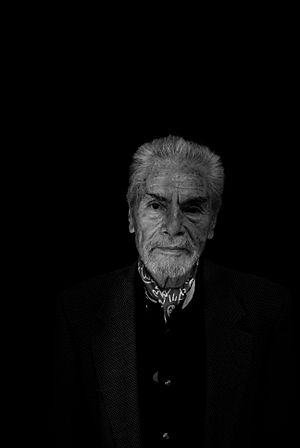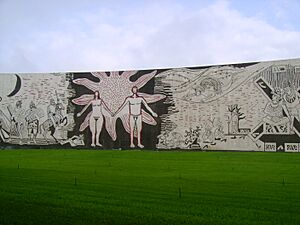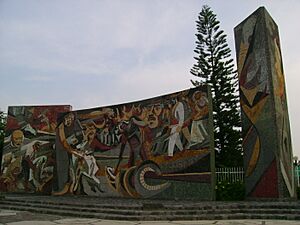Adolfo Mexiac facts for kids
Adolfo Mexiac (born August 7, 1927 – died October 13, 2019) was a famous Mexican artist. He was best known for his amazing graphic art, which often shared important messages about society and politics. He worked closely with a group called the Taller de Gráfica Popular and with another artist named Leopoldo Méndez. Adolfo Mexiac also painted many large murals. His most important mural shows the history of human laws and is located at the University of Colima. In 2011, Mexico honored him with a special "national homage" at the Museo de la Estampa in Mexico City.
Life of Adolfo Mexiac
Adolfo Mexiac was born on August 7, 1927, in a place called Cuto de la Esperanza, in Michoacán, Mexico. He started learning to paint at the Escuela Popular de Bellas Artes in Morelia. Later, he moved to Mexico City to study at the Escuela Nacional de Artes Plásticas. He also studied at the Escuela Nacional de Pintura, Escultura y Grabado "La Esmeralda", where one of his teachers was José Chávez Morado.
He spent three years learning engraving at the Escuela de Artes del Libro. He became very good at wood engraving. He even found a new way to put images together using a jigsaw method. This allowed him to add many colors, which was quite new for this type of art.
When he was seventeen, he changed his last name from Mejía to Mexiac. His art and his life were connected to supporting ideas that helped regular people and fought for fairness. He said that the artist Leopoldo Méndez, who also worked on political art, treated him like his own son.
Adolfo Mexiac's Career
Adolfo Mexiac is seen as one of Mexico's most important graphic artists. In the early 1950s, he studied with artists Pablo O'Higgins and Ignacio Aguirre. He sometimes helped them paint murals. Pablo O'Higgins saw Mexiac's drawings and invited him to join the Taller de la Gráfica Popular. This was a group of artists who used their art to share important messages.
Mexiac joined the group and worked there for ten years. He created lithographs and drawings with Leopoldo Méndez, Pablo O'Higgins, and Luis Arenal. His art often focused on social and political issues. For example, he supported striking miners and spoke out against powerful countries controlling weaker ones.
One of his famous engravings is called Libertad de expresión (Freedom of Expression). It talks about a time when the government in Guatemala was overthrown in 1954. The artwork shows an Indigenous person with their mouth covered by chains and a padlock that says "USA." This print caused a lot of discussion in Mexico. Mexiac said that Mexican artists have never had complete freedom to express themselves.
He was also a member of the Salón de la Plástica Mexicana, a group of important Mexican artists. In 1953, another artist named Alberto Beltrán asked him to join the Instituto Nacional Indigenista in Chiapas. There, Mexiac created visual tools to help communities in the highlands of that state. After working in Chiapas, he became a professor at the Escuela de Artes Plásticas. He taught there for twenty-six years. In the 1960s, he worked with photographers Mariana Yampolsky and Manuel Álvarez Bravo, as well as Leopoldo Méndez.
Throughout his career, Mexiac had about eighty individual art shows. These shows took place in Mexico and in other countries like Chile, Belgium, Japan, and Italy. In 2010, he had an exhibition called Una reflexión sobre el Bicentenario. This show honored the 200th anniversary of Mexico's independence. It was held at the Alfredo Guati Rojo National Watercolor Museum.
Mexiac painted several murals. His most important mural is in Colima. This mural is called El hombre y la mujer en armonía con su universo (Man and Woman in Harmony with Their Universe). It is located at the University of Colima. He created it in 2002 using a stone mosaic with marble, tezontle (a type of volcanic rock), and other materials. The mural tells the story of law throughout human history.
Other murals he created include La ayuda del hombre por el hombre (Man's Help for Man) at the Instituto Nacional Indigenista in Mexico City. He also painted Formación del Estado Mexicano (Formation of the Mexican State) and Los constitucionales de México (The Constitutionalists of Mexico). The last one was at the Palacio Legislativo in Mexico City. This work was accidentally damaged, so Mexiac repainted it in 1992.
Adolfo Mexiac received many awards for his work. He won the Casa de las Américas Prize from Cuba in 1964. In 2010, a documentary film about him was made by Othón Salazar, called Libertad de expresión de Adolfo Mexiac. In 2011, Mexico held a special national tribute to him. This tribute took place at the Museo Nacional de la Estampa. It included a look back at all his artwork from his life. This special show then traveled to different museums across Mexico. It visited cities like Toluca, Puebla, Oaxaca, Monterrey, and Saltillo. It also went to the Mexic-Arte Museum in Austin, Texas.
Adolfo Mexiac's Art Style
Adolfo Mexiac was inspired by the art of José Guadalupe Posada, Leopoldo Méndez, and José Chávez Morado. He believed that art, especially printmaking, should have a social message. He once said that if artists want to create art that brings about change, they should use printmaking. He called it a "noble means of artistic expression." He felt that printmaking has always been good at speaking out, fighting for causes, and encouraging people who have been treated unfairly.
See also
 In Spanish: Adolfo Mexiac para niños
In Spanish: Adolfo Mexiac para niños




